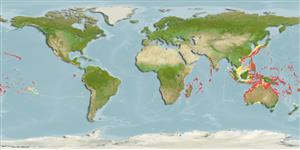Classification / Names
Common names from other countries
Main reference
Size / Weight / Age
Max length : 18.0 cm TL male/unsexed; (Ref. 48636)
Environment
Marine; reef-associated; depth range 9 - 170 m (Ref. 30874), usually 16 - ? m (Ref. 9710)
Climate / Range
Tropical, preferred ?
Distribution
Indo-Pacific: East Africa to Pitcairn (excluding Easter Island), north to Japan, south to the Great Barrier Reef. Throughout Oceania. Not recorded from the Arabian Peninsula or the southern coast of Asia.
Countries | FAO areas | Ecosystems | Occurrences | Introductions
Short description
Dorsal
spines
(total): 5;
Dorsal
soft rays
(total): 21-22;
Anal
spines: 1;
Anal
soft rays: 17 - 18. Indian Ocean form shows lined versus barred pattern (Ref. 48636). Spinous portion of dorsal fin black at base, deep red distally. A longitudinal row of black spots 8 or 9 subquadrangular red to dark brown spots along back alternating with similar but more vertically elongate red spots on lower side. Two narrow bright red bars at pectoral-fin base (Ref 42740).
IUCN Red List Status (Ref. 115185)
Threat to humans
Harmless
Human uses
Aquarium: commercial
More information
Common namesSynonymsMetabolismPredatorsEcotoxicologyReproductionMaturitySpawningFecundityEggsEgg development
ReferencesAquacultureAquaculture profileStrainsGeneticsAllele frequenciesHeritabilityDiseasesProcessingMass conversion
Tools
Special reports
Download XML
Internet sources
Estimates of some properties based on models
Phylogenetic diversity index
PD50 = 0.5000 many relatives (e.g. carps) 0.5 - 2.0 few relatives (e.g. lungfishes)
Trophic Level
3.4 ±0.45 se; Based on food items.
Resilience
High, minimum population doubling time less than 15 months (Preliminary K or Fecundity.)
Vulnerability
Low to moderate vulnerability (27 of 100)
Price category
